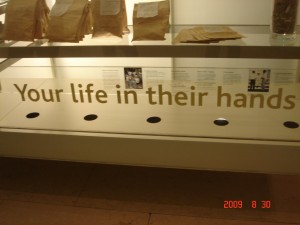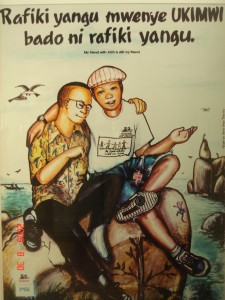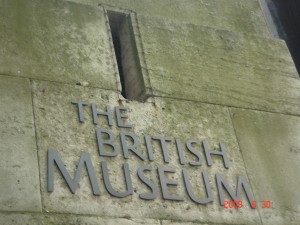
A description under Cradle to Grave by Pharmacopoei states:
“Cradle to Grave explores our approach to health in Britain today and addresses some of the ways that people deal with sickness and try to secure well being.”
It is an understatement when I say that I was surprised to see an exhibit titled “Living and Dying” which is located in Wellcome Trust Gallery in the British Museum. The gallery explores how people around the world deal with “the tough realities of life and death.” The exhibit further explores health challenges shared by many through out the world, and the ways that those individuals might deal with them based on their cultures, beliefs, and areas of residence. Creatively displaying visual representations of photography, quotes, documents, captions, and instillations the exhibit investigated people’s reliance on relationships in order to maintain their well-being. Exploration of people’s relationships with each other, the animal world, ancestors, land and sea for their well being are included.
As I walked down the stairs of the British Museum to the ground floor expecting to see the Aztecs (Mexicana) exhibition featuring tribal sculptures, history, and art instead I was greeted by Cradle to Grave. The central installation consists of two lengths of fabric illustrating the medical stories of a man and a woman. Created by Susie Freeman, who is a textile artist, David Critchley, a video artist, and Dr Liz Lee, a general practitioner, each piece contains over 14,000 drugs representing the estimated average prescribed to every person in Britain in their lifetime, tucked away in ‘pockets’ of knitted nylon filament. This specific piece explored the approach to health in Britain and the personal approach of the piece demonstrates that maintaining well-being is more complex than just treating illness. With 14,000 drugs, the artists included photographs and some treatments that two individuals have gone through. The common treatments for the man and a woman included an injection of vitamin K and immunisations, and both individuals have taken antibiotics and painkillers at various times. Other treatments were more specific such as for asthma and hay fever that the man suffered from when younger and quitting of smoking at seventy due to bad chest infection. The piece showed his death from a stroke at the age of seventy-six, “having taken as many pills in the last ten years of his life as in the first sixty-six.” The woman’s treatments included contraceptive pills and hormone replacement therapy. She was successfully treated for breast cancer. She is still alive at eighty-two although she does suffer from arthritis and diabetes.

Trying to figure out the purpose of the exhibit, I believe the artists are trying to explore the factor of living in the “modern” society and how treating an illness is not the only factor that needs to be taken into account. By representing two individuals, a male and a female, in the British society through photographs with their own captions written down, and objects such as contraceptive pills, a glass of wine, and needles allowed the viewers to relate in some way to the lives these characters have led and how it affected their health.
Surrounding the installation, representations of health in countries such as Tanzania, China and India were included. “Facing HIV/AIDS” explored the approaches these communities have to the AIDS epidemic. The stigmas attached to being diagnosed with AIDS in these societies prevent many from seeking treatments; therefore, the need for education programmes, community workshops and poster campaigns which aim to make it easier to discuss and practice safe sex. “Praying for Health” showed how certain communities use prayer and traditional medicine to treat their illness. In contrast to the British healing, it is a very different approach. Focusing more on the person and the higher being rather than the pharmaceutical companies and the business aspect, societies in Tanzania, India and China focus on the being and their needs. Although the treatment of such illnesses such as HIV/AIDS can not be done only through traditional healing, their approach should serve as a guide to western societies where a more humane way to treat patients. There needs to be an infusion between the two worlds.

"My friend with AIDS is still my friend."

